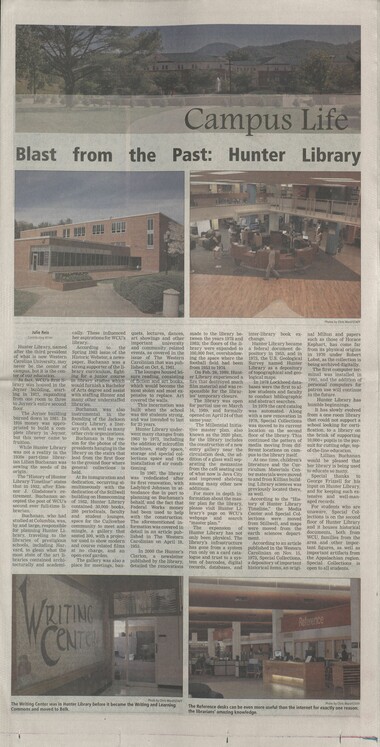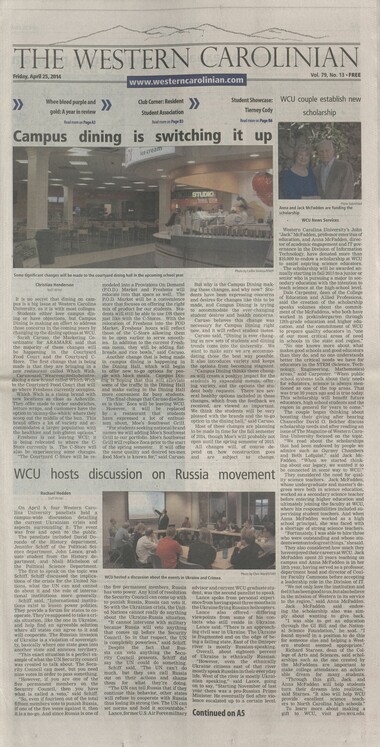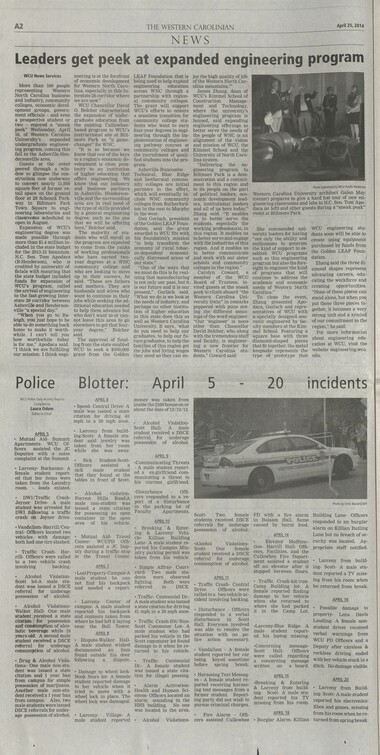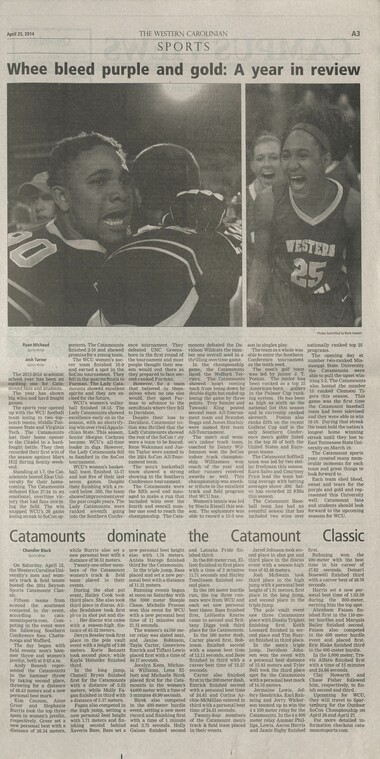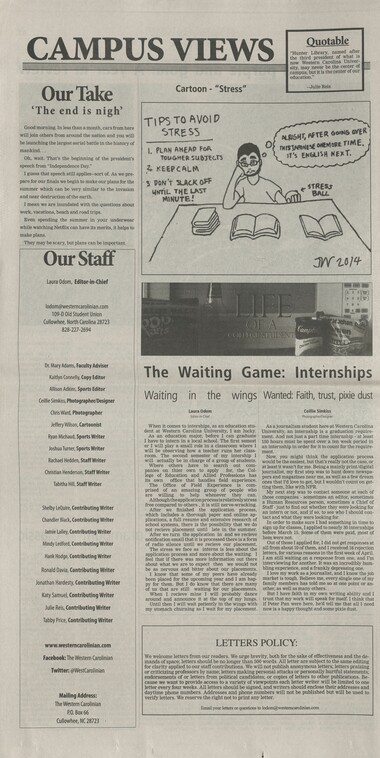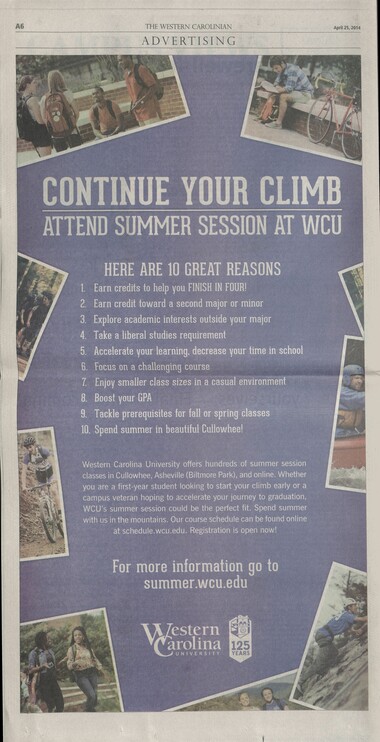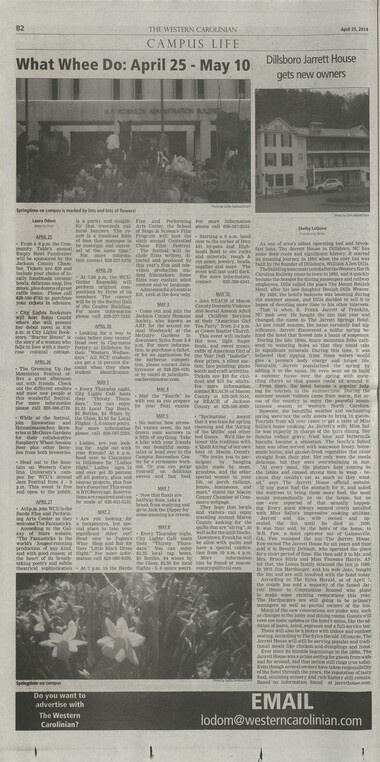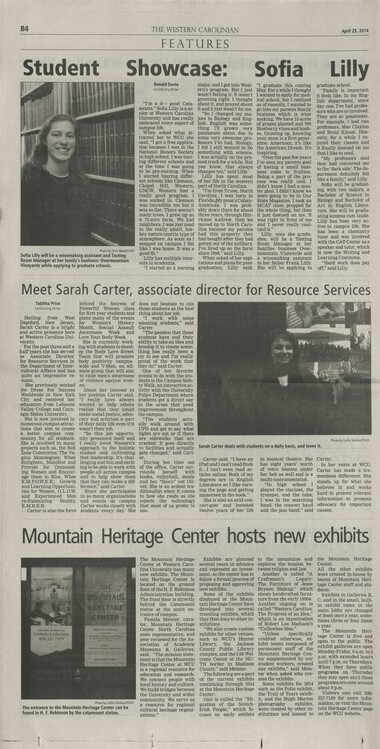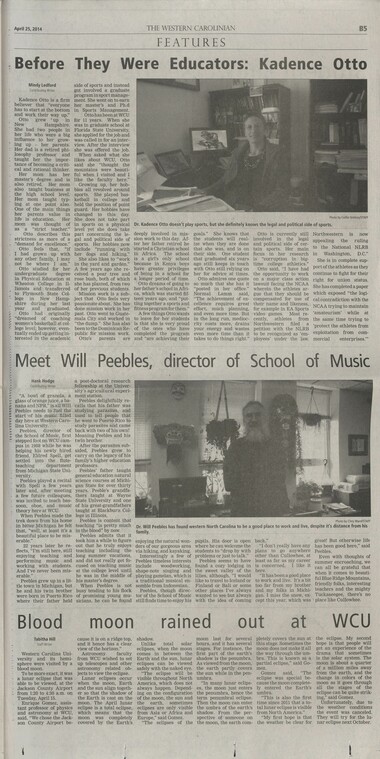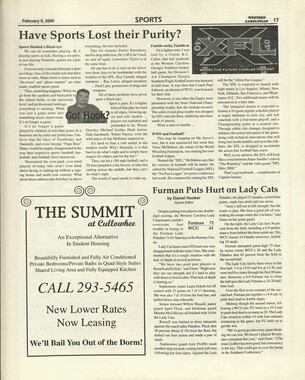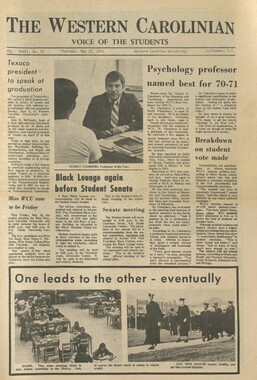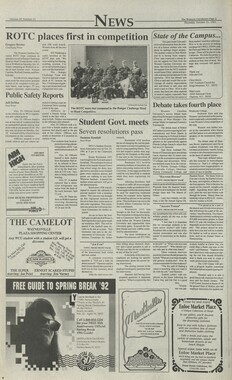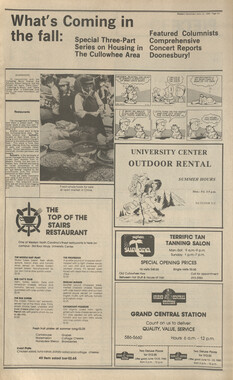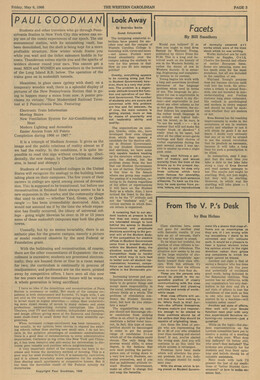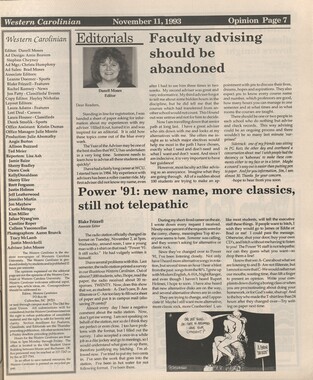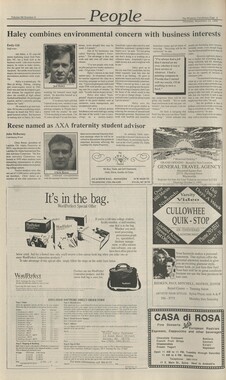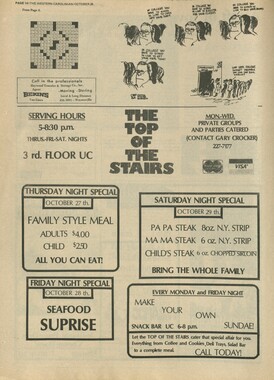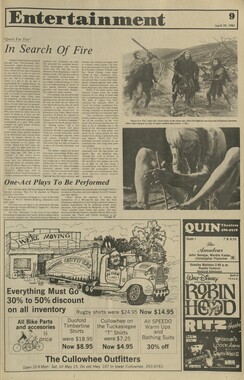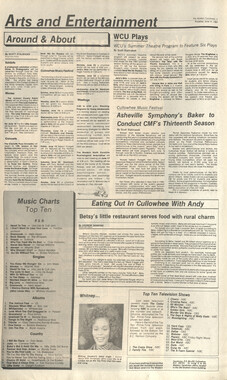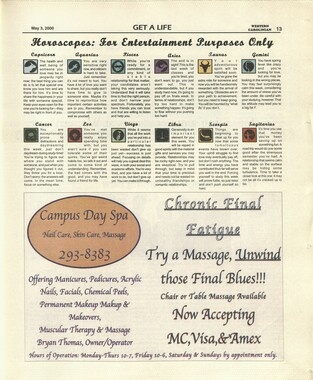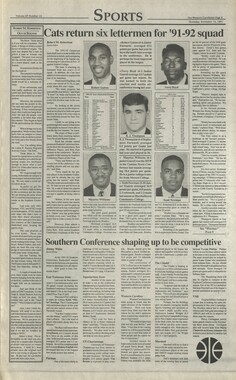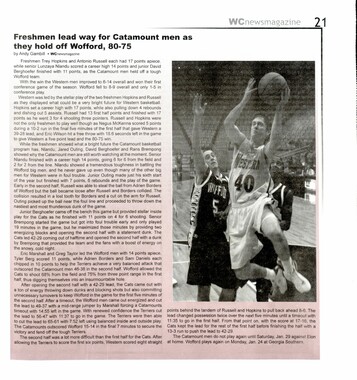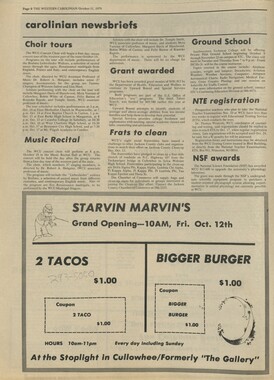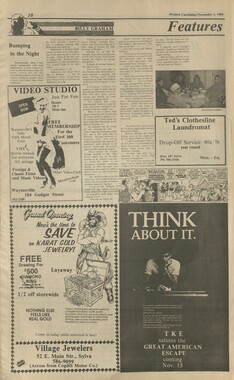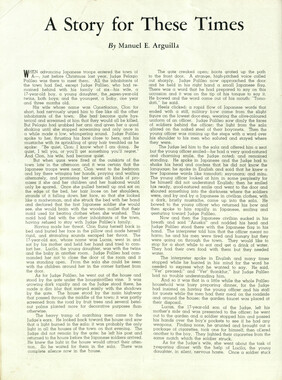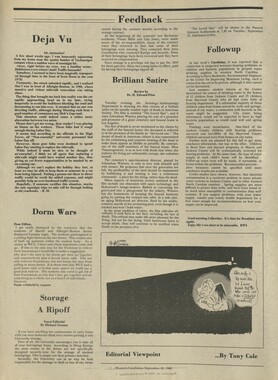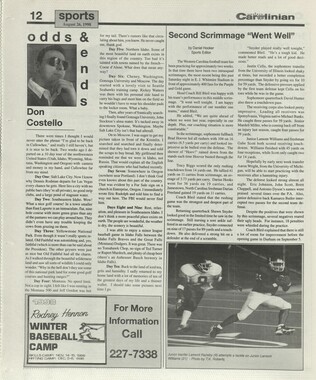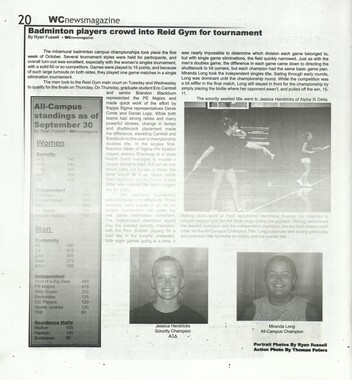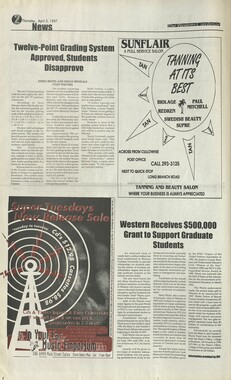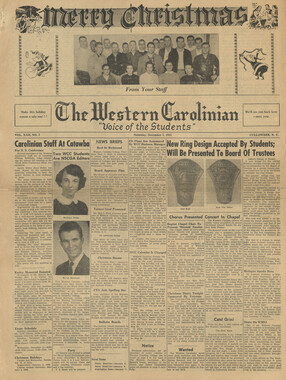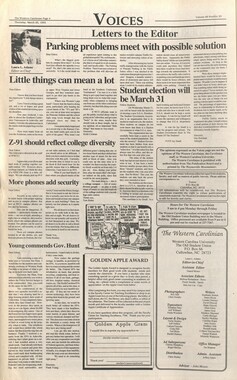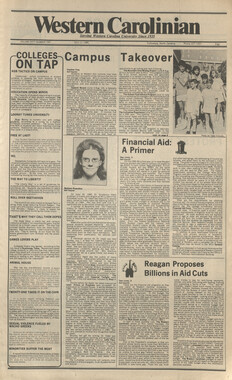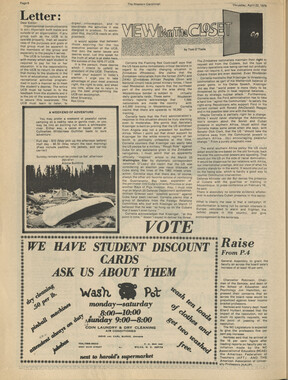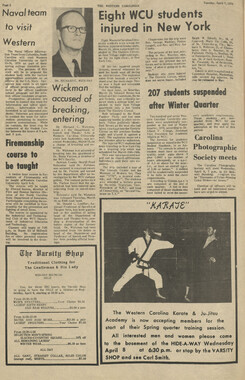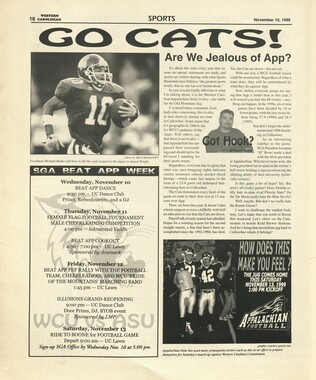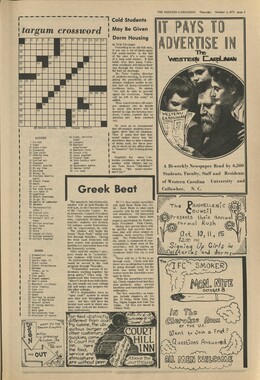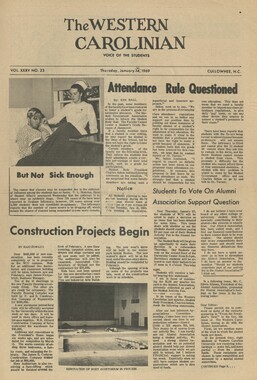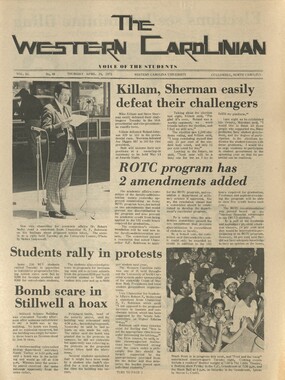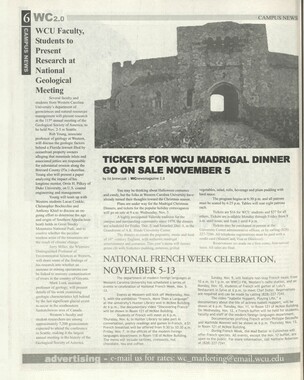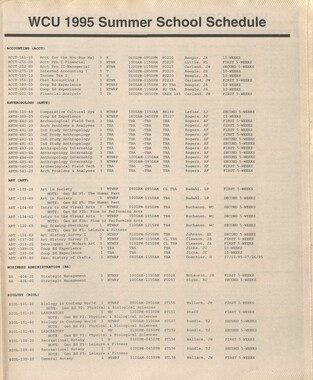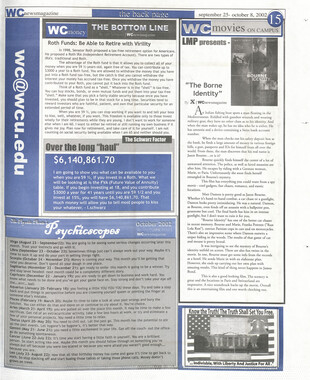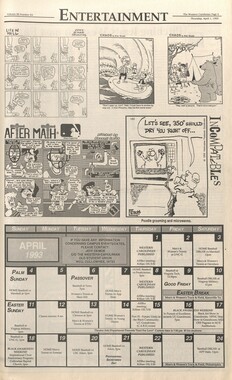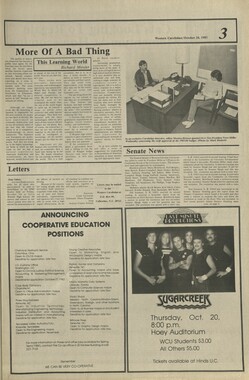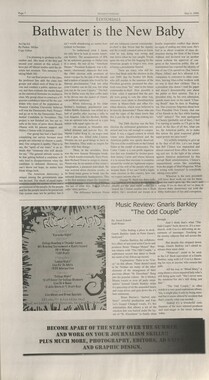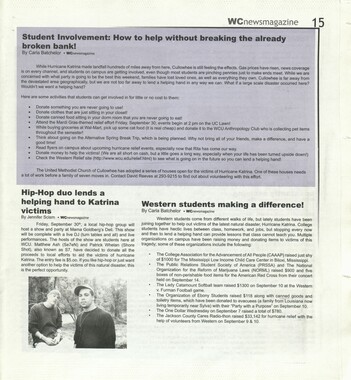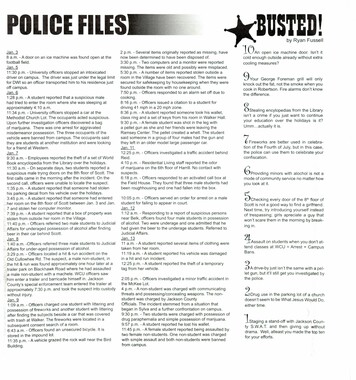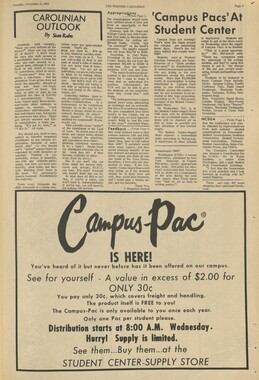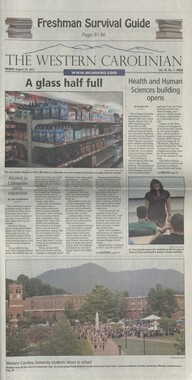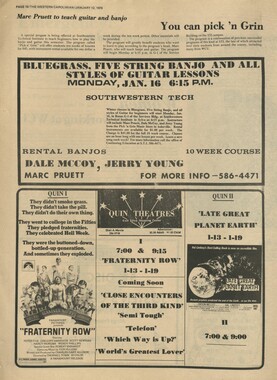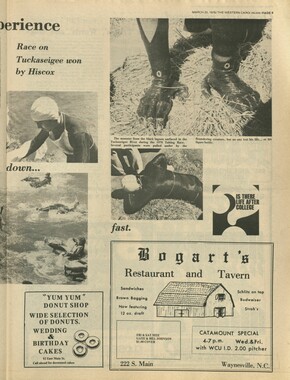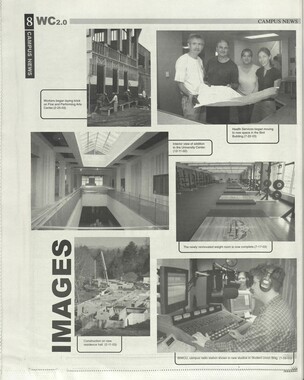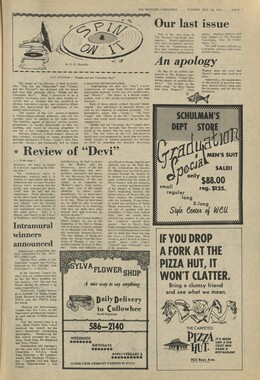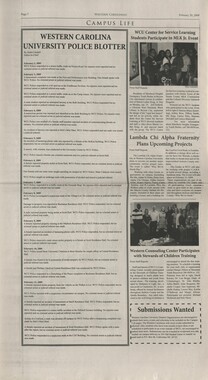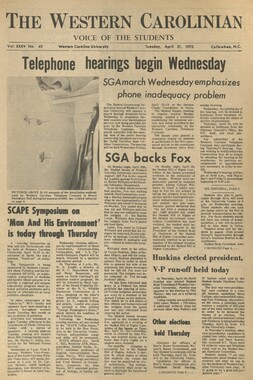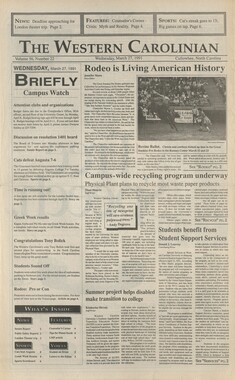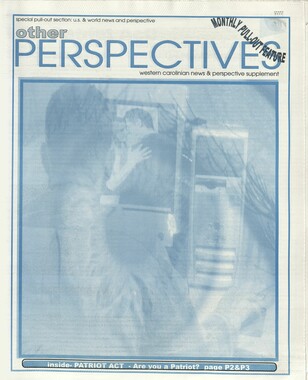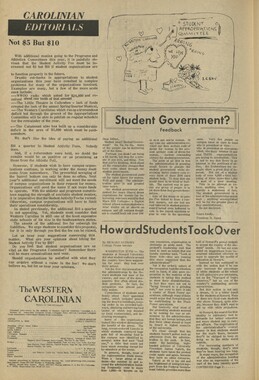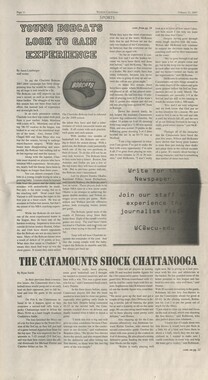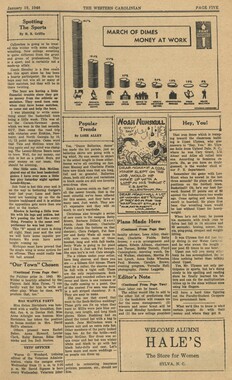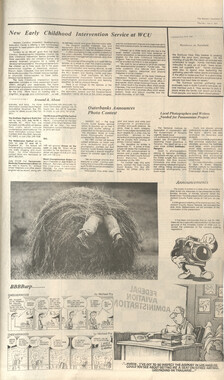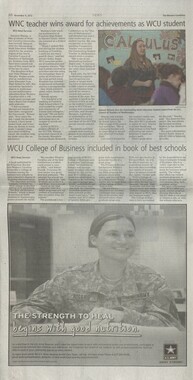Western Carolina University (21)
View all
- Canton Champion Fibre Company (2308)
- Cherokee Traditions (291)
- Civil War in Southern Appalachia (165)
- Craft Revival (1942)
- George Masa Collection (137)
- Great Smoky Mountains - A Park for America (3080)
- Highlights from Western Carolina University (422)
- Horace Kephart (998)
- Journeys Through Jackson (159)
- LGBTQIA+ Archive of Jackson County (89)
- Oral Histories of Western North Carolina (318)
- Picturing Appalachia (6617)
- Stories of Mountain Folk (413)
- Travel Western North Carolina (153)
- Western Carolina University Fine Art Museum Vitreograph Collection (129)
- Western Carolina University Herbarium (92)
- Western Carolina University: Making Memories (738)
- Western Carolina University Publications (2491)
- Western Carolina University Restricted Electronic Theses and Dissertations (146)
- Western North Carolina Regional Maps (71)
- World War II in Southern Appalachia (131)
University of North Carolina Asheville (6)
View all
- Allanstand Cottage Industries (62)
- Appalachian National Park Association (53)
- Bennett, Kelly, 1890-1974 (1463)
- Berry, Walter (76)
- Brasstown Carvers (40)
- Carver, George Washington, 1864?-1943 (26)
- Cathey, Joseph, 1803-1874 (1)
- Champion Fibre Company (233)
- Champion Paper and Fibre Company (297)
- Cherokee Indian Fair Association (16)
- Cherokee Language Program (22)
- Crowe, Amanda (40)
- Edmonston, Thomas Benton, 1842-1907 (7)
- Ensley, A. L. (Abraham Lincoln), 1865-1948 (275)
- Fromer, Irving Rhodes, 1913-1994 (70)
- George Butz (BFS 1907) (46)
- Goodrich, Frances Louisa (120)
- Grant, George Alexander, 1891-1964 (96)
- Heard, Marian Gladys (60)
- Kephart, Calvin, 1883-1969 (15)
- Kephart, Horace, 1862-1931 (313)
- Kephart, Laura, 1862-1954 (91)
- Laney, Gideon Thomas, 1889-1976 (439)
- Masa, George, 1881-1933 (61)
- McElhinney, William Julian, 1896-1953 (44)
- Niggli, Josephina, 1910-1983 (10)
- North Carolina Park Commission (105)
- Osborne, Kezia Stradley (9)
- Owens, Samuel Robert, 1918-1995 (11)
- Penland Weavers and Potters (36)
- Roberts, Vivienne (15)
- Roth, Albert, 1890-1974 (142)
- Schenck, Carl Alwin, 1868-1955 (1)
- Sherrill's Photography Studio (2565)
- Southern Highland Handicraft Guild (127)
- Southern Highlanders, Inc. (71)
- Stalcup, Jesse Bryson (46)
- Stearns, I. K. (213)
- Thompson, James Edward, 1880-1976 (226)
- United States. Indian Arts and Crafts Board (130)
- USFS (683)
- Vance, Zebulon Baird, 1830-1894 (1)
- Weaver, Zebulon, 1872-1948 (58)
- Western Carolina College (230)
- Western Carolina Teachers College (282)
- Western Carolina University (2008)
- Western Carolina University. Mountain Heritage Center (18)
- Whitman, Walt, 1819-1892 (10)
- Wilburn, Hiram Coleman, 1880-1967 (73)
- Williams, Isadora (3)
- Cain, Doreyl Ammons (0)
- Crittenden, Lorraine (0)
- Rhodes, Judy (0)
- Smith, Edward Clark (0)
- Appalachian Region, Southern (3032)
- Asheville (N.C.) (1945)
- Avery County (N.C.) (26)
- Blount County (Tenn.) (195)
- Buncombe County (N.C.) (1680)
- Cherokee County (N.C.) (283)
- Clay County (N.C.) (556)
- Graham County (N.C.) (238)
- Great Smoky Mountains National Park (N.C. and Tenn.) (535)
- Haywood County (N.C.) (3573)
- Henderson County (N.C.) (70)
- Jackson County (N.C.) (4925)
- Knox County (Tenn.) (35)
- Knoxville (Tenn.) (13)
- Lake Santeetlah (N.C.) (10)
- Macon County (N.C.) (421)
- Madison County (N.C.) (216)
- McDowell County (N.C.) (39)
- Mitchell County (N.C.) (135)
- Polk County (N.C.) (35)
- Qualla Boundary (982)
- Rutherford County (N.C.) (78)
- Swain County (N.C.) (2185)
- Transylvania County (N.C.) (270)
- Watauga County (N.C.) (12)
- Waynesville (N.C.) (86)
- Yancey County (N.C.) (72)
- Aerial Photographs (3)
- Aerial Views (60)
- Albums (books) (4)
- Articles (1)
- Artifacts (object Genre) (228)
- Bibliographies (1)
- Biography (general Genre) (2)
- Cards (information Artifacts) (38)
- Clippings (information Artifacts) (193)
- Copybooks (instructional Materials) (3)
- Crafts (art Genres) (622)
- Depictions (visual Works) (21)
- Design Drawings (1)
- Digital Moving Image Formats (2)
- Drawings (visual Works) (185)
- Envelopes (115)
- Exhibitions (events) (1)
- Facsimiles (reproductions) (1)
- Fiction (general Genre) (4)
- Financial Records (12)
- Fliers (printed Matter) (67)
- Glass Plate Negatives (381)
- Guidebooks (2)
- Internegatives (10)
- Interviews (823)
- Land Surveys (102)
- Letters (correspondence) (1070)
- Manuscripts (documents) (618)
- Maps (documents) (177)
- Memorandums (25)
- Minutes (administrative Records) (59)
- Negatives (photographs) (6090)
- Newsletters (1290)
- Newspapers (2)
- Notebooks (8)
- Occupation Currency (1)
- Paintings (visual Works) (1)
- Pen And Ink Drawings (1)
- Periodicals (194)
- Personal Narratives (10)
- Photographs (12977)
- Plans (maps) (1)
- Poetry (6)
- Portraits (4568)
- Postcards (329)
- Programs (documents) (181)
- Publications (documents) (2444)
- Questionnaires (65)
- Relief Prints (26)
- Sayings (literary Genre) (1)
- Scrapbooks (282)
- Sheet Music (2)
- Slides (photographs) (402)
- Songs (musical Compositions) (2)
- Sound Recordings (802)
- Specimens (92)
- Speeches (documents) (18)
- Tintypes (photographs) (8)
- Transcripts (329)
- Text Messages (0)
- A.L. Ensley Collection (275)
- Appalachian Industrial School Records (7)
- Appalachian National Park Association Records (336)
- Axley-Meroney Collection (2)
- Bayard Wootten Photograph Collection (20)
- Bethel Rural Community Organization Collection (7)
- Blumer Collection (5)
- C.W. Slagle Collection (20)
- Canton Area Historical Museum (2110)
- Carlos C. Campbell Collection (462)
- Cataloochee History Project (64)
- Cherokee Studies Collection (4)
- Daisy Dame Photograph Album (5)
- Daniel Boone VI Collection (1)
- Doris Ulmann Photograph Collection (112)
- Elizabeth H. Lasley Collection (1)
- Elizabeth Woolworth Szold Fleharty Collection (4)
- Frank Fry Collection (95)
- George Masa Collection (173)
- Gideon Laney Collection (452)
- Hazel Scarborough Collection (2)
- Hiram C. Wilburn Papers (28)
- Historic Photographs Collection (236)
- Horace Kephart Collection (861)
- Humbard Collection (33)
- Hunter and Weaver Families Collection (1)
- I. D. Blumenthal Collection (4)
- Isadora Williams Collection (4)
- Jesse Bryson Stalcup Collection (47)
- Jim Thompson Collection (224)
- John B. Battle Collection (7)
- John C. Campbell Folk School Records (80)
- John Parris Collection (6)
- Judaculla Rock project (2)
- Kelly Bennett Collection (1482)
- Love Family Papers (11)
- Major Wiley Parris Civil War Letters (3)
- Map Collection (12)
- McFee-Misemer Civil War Letters (34)
- Mountain Heritage Center Collection (4)
- Norburn - Robertson - Thomson Families Collection (44)
- Pauline Hood Collection (7)
- Pre-Guild Collection (2)
- Qualla Arts and Crafts Mutual Collection (12)
- R.A. Romanes Collection (681)
- Rosser H. Taylor Collection (1)
- Samuel Robert Owens Collection (94)
- Sara Madison Collection (144)
- Sherrill Studio Photo Collection (2558)
- Smoky Mountains Hiking Club Collection (616)
- Stories of Mountain Folk - Radio Programs (374)
- The Reporter, Western Carolina University (510)
- Venoy and Elizabeth Reed Collection (16)
- WCU Gender and Sexuality Oral History Project (36)
- WCU Mountain Heritage Center Oral Histories (25)
- WCU Oral History Collection - Mountain People, Mountain Lives (71)
- WCU Students Newspapers Collection (1923)
- Western North Carolina Tomorrow Black Oral History Project (69)
- William Williams Stringfield Collection (2)
- Zebulon Weaver Collection (109)
- African Americans (390)
- Appalachian Trail (35)
- Artisans (521)
- Cherokee art (84)
- Cherokee artists -- North Carolina (10)
- Cherokee language (21)
- Cherokee pottery (101)
- Cherokee women (208)
- Church buildings (190)
- Civilian Conservation Corps (U.S.) (111)
- College student newspapers and periodicals (2012)
- Dams (108)
- Dance (1023)
- Education (222)
- Floods (63)
- Folk music (1015)
- Forced removal, 1813-1903 (2)
- Forest conservation (220)
- Forests and forestry (1198)
- Gender nonconformity (4)
- Great Smoky Mountains National Park (N.C. and Tenn.) (181)
- Hunting (47)
- Landscape photography (25)
- Logging (122)
- Maps (83)
- Mines and mineral resources (9)
- North Carolina -- Maps (18)
- Paper industry (38)
- Postcards (255)
- Pottery (135)
- Railroad trains (72)
- Rural electrification -- North Carolina, Western (3)
- School integration -- Southern States (2)
- Segregation -- North Carolina, Western (5)
- Slavery (5)
- Sports (452)
- Storytelling (243)
- Waterfalls -- Great Smoky Mountains (N.C. and Tenn.) (66)
- Weaving -- Appalachian Region, Southern (280)
- Wood-carving -- Appalachian Region, Southern (328)
- World War, 1939-1945 (174)
Western Carolinian Volume 79 Number 13
Item
Item’s are ‘child’ level descriptions to ‘parent’ objects, (e.g. one page of a whole book).
-
-
Julie Reis Contributing Writer cally. These influenced her aspirations for WCUs library. According. to. the Spring 1983 issue of the Historic Webster, a news- paper, Buchanan was a strong supporter of the li- eee eee Hebe ing for a amigas r ate would furnish a Bachelor of Arts degree and assist with staffing Hunter and many other understaffed libraries. Buchanan was _ also instrumental in the founding of the Jackson County Library, a liter- ary club, as well as many other civic organizations. Buchanan is the rea- son for the photos of the presidents hanging in the library on the stairs that lead from the first floor to the ground floor where Hunter Library, named after the third president of what is now Western Carolina University, may never be the center of CaMnis, but it is the cen- r ducati oe brary was Molise in ae Joyner | building, start- ing in 1917, expanding from one room to three -to Joyner's entire second floor. The Joyner building burned down in 1981. In 1916 money was appro- priated to build a com- plete library in Joyner, but this never came to fruition. While Hunter Library was not a reality in the 1930s part-time librar- ian Lilian Buchanan was sewing the seeds of its general collections is origin. held. The History of Hunter At its inauguration and Library Timeline states that in 1932, after Elea- nor J. Gladstones re- tirement, Buchanan ac- cepted the post of WCUs second ever full-time li- brarian. Buchanan, who had studied at Columbia, was, by and large, responsible for planning Hunter Li- brary, traveling to the libraries of prestigious schools, including Har- vard, to glean what the most state of the art li- braries contained archi- tecturally and academi- dedication, occurring si- multaneously with the dedication of the Stillwell building on Homecoming of 1952, Hunter Library contained 30,000 books, 200 periodicals, faculty and student lounges, space for the Cullowhee mingle, a gallery that seated 300, with a projec- tor used to show modern and course related films at no charge, and an open-roof garden. The gallery was also a place for meetings, ban- community to meet and . -quets, lectures, dances, art showings and other important university and community related events, as covered in the issue of The Western Carolinian that was pub- lished on Oct. 6, 1961. _ The g oumees housed lei- which would become the most stolen and most ex- pensive to replace. Art covered the walls. This incarnation was built when the school was 600 students strong, and was intended to last for 25 years. Hunter Library under- went many changes from 1963 to 1973, including the addition of microfilm machines, study space, ' storage and special col- lections space and the installation of air condi- tioning. In 1967, the library was. rededicated after its first renovation, with Ladybird Johnson in at-. tendance due in part to planning on Buchanans behalf, and the fact that Federal Works money had been used to help with the construction. The aforementioned in- formation was covered in detail in an article pub- lished in The Western Carolinian on April 18, 1953. In 2000 the Hunters Clarion, a newsletter published by the library, dee the renovations - Photo by Chris Ward/STAFF The Writing Center was in Hunter Library before it became the Writing and Learning Commons and moved to Belk. made to the library be- tween the years 1978 and 1983; the floors of the li- brary were expanded to 100,000 feet, overshadow- ing the space where the football field had been from 1953 to 1974. On Feb. 26, 1989, Hunt- er Library experienced a fire that destroyed much film material and was re- sponsible for the librar- ies temporary closure. The library was open for partial use on March 14, 1989, and formally opened on April 24 of that same year, ~ The Millennial Initia- tive master plan, also known as the 2020 plan, for the library includes the construction of a new entry gallery near the circulation desk, the ad- dition of a glass wall sep- arating the mezzanine from the caf seating out of what now is Java City and improved shelving among many other new additions. For more in depth in- formation about the mas- ter plan for the library, please visit Hunter Li- brarys page on WCUs webpage and search master plan. The expansion of Hunter Library has not only been physical. The librarys infrastructure has gone from a system run only on a card cata- logue and trust to a sys- tem of barcodes, digital records, databases, and the librar inter-library book ex- change. Hunter Library esate a federal document de- pository in 1958, and in 1973, the U.S. Geological Survey named Hunter Library as a depository of topographical and geo- logical maps. In 1978 Lockheed data- bases were the first to al- low students and faculty to conduct bibliographic and abstract searches. In 1979 the card catalog was automated. Along with a new renovation in 1978, Special Collections was moved to its current location on the second floor of the library. This continued the pattern of media moving from dif ferent locations on cam- pus to the library itself. At one time, childrens literature and the Cur- riculum Materials Cen- ter materials were moved to and from Killian build- ing. Library sciences was previously located there, as well. According to the His- tory of Hunter Library Timeline, the Media Center and Special Col- lections were moved from Stillwell, and maps were moved from the earth sciences depart- ment. According to an article published in the Western Carolinian on Nov. 15, 1978, Special Collections, a depository of important historical items, an origi- ing knowledge. BSVhGbs th ssby9 Tes sip bivaes MEny eavOsbcvrbsarRovane stones Fer PAID INT PSAP PAUL RNDEEER LPO PETU OE DES DEP YLLED EO ADIILL FP OA SDE br EDP UER/EEPOALPN OEE aba DYLOON vty AFA Vb be - unaware, nal Milton and papers | such as those of Horace Kephart, has come far from its physical origins in 1970 under Robert Lobst, as the collection is being archived digitally. The first computer ter- minal was installed in 1995, and the addition of personal computers for patron use will continue in the future. Hunter Library has humble beginnings. It has slowly evolved from a one room library that could not support a school looking for certi- | fication, to a library on the brink of supporting 10,000+ pupils in the pur- suit for cutting edge, top- of-the-line education. Lillian Buchanan would be pleased that her library is being used to educate so many. Special thanks to George Frizzell for his input on Hunter Library, and for keeping such:ex- tensive and well-man- aged records. For students who are Special Col- lections is on the second floor of Hunter Library and it houses historical documents, both from WCU, families from the area and other impor- tant figures, as well as important artifacts from the Appalachian region. Special Collections is open to all students. Photo by Chris Ward/STAFE The Reference desks can be even more useful than the internet for exactly one reason:
Object
Object’s are ‘parent’ level descriptions to ‘children’ items, (e.g. a book with pages).
-
The Western Carolinian is Western Carolina University's student-run newspaper. The paper was published as the Cullowhee Yodel from 1924 to 1931 before changing its name to The Western Carolinian in 1933.
-
